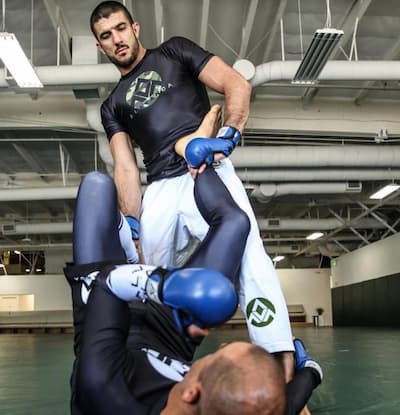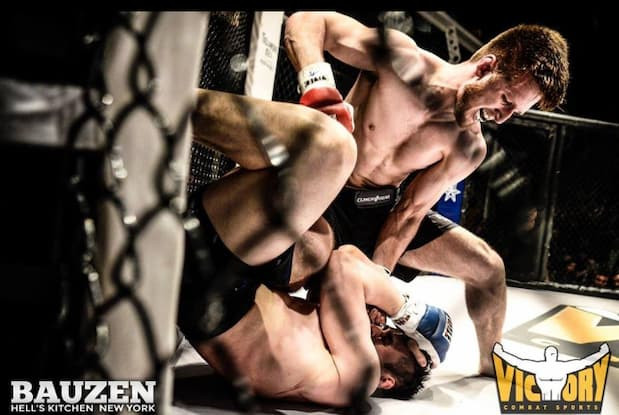Over the course of less than 30 years, the world of mixed martial arts has evolved into one of the premier sports in the United States. This is owed largely to the popularity of UFC (Ultimate Fighting Championship), as well as other organizations throughout the world. On top of being a popular spectator sport, there has also been a surge in the number of people participating in MMA competitions, as well as a surge in the number of people who train like MMA fighters, even if these athletes do not plan to fight competitively. While it would seem reasonable to assume that one could use a search engine to find a nearby gym that offers MMA training, this is not the case—especially in New York. To fully appreciate the current climate of MMA training in New York City, one must first grasp the history of MMA in the state and beyond.
The History of MMA
MMA-style fighting is not new. Fighters have been grappling, striking, and putting opponents into submission holds for thousands of years, and multiple cultures have their own unique styles of fighting that closely resemble modern MMA style. In the U.S., however, this type of fighting—initially known as no holds barred, no rules fighting, or full contact fighting—did not have mainstream appeal as either a spectator sport or fighting style. Most fighters mastered a single style and fought in tournaments that allowed that style alone; there was no mixing. Until relatively recently, the rare tournaments that allowed MMA-style fighting typically involved a fighter who had mastered one style against a fighter who had mastered another.
The Birth of Modern MMA
This changed abruptly in 1993 with the first Ultimate Fighting Championship (UFC 1). Apart from being an extremely popular tournament that sparked significant interest in MMA-style fighting, UFC 1 also introduced the Gracie style of Brazilian jiu-jitsu to a larger audience when Royce Gracie, a master of the style, not only won the tournament, but beat his three opponents in a total of just under five minutes. In the wake of the event, not only were fighters suddenly interested in participating in MMA contests; they were also interested in learning Brazilian jiu-jitsu to make them better and more well-rounded fighters.

MMA in the 1990sThroughout the U.S., practitioners of various martial arts began to learn the kind of grappling that had allowed Gracie to cruise through the tournament. After honing their ground fighting skills, these fighters eventually wanted to participate in MMA tournaments. Unfortunately, many tournaments were not run particularly well, and the sport very quickly garnered a bad reputation. Consequently, most states explicitly banned the sport during the 1990s, which pushed it underground.
The Evolution of MMA (1990s-2000s)
Though MMA was banned, organizations that allowed ground fighting started to attract fighters who had learned jiu-jitsu. In some cases, these organizations were created because of the growing popularity of MMA-style ground fighting, as was the North American Grapplers Association, which was founded in 1995. In other cases, fighters were attracted to tournaments held by existing groups that allowed grappling—such as kickboxing organizations. Not only did these organizations end up influencing the styles of many fighters; they also influenced the rules and regulations of MMA organizations. By the late 1990s, these rules had been adopted by UFC, and the lawless reputation of MMA began to fade away. Within a few years, most states ended their bans on the sport.
The Legal Status of MMA in New York
This was not the case in New York. In fact, MMA events were not legal in New York until 2016. While it may seem as though Albany’s refusal to lift the ban was due to their reluctance to condone a sport that seems very violent, the actual reason was due to lobbying efforts on the part of several parties who wanted to protect their political interests. To reiterate: The ban on MMA events in New York, which lasted from 1997 until 2016, was due to politics and not because of any inherent danger to participants.
MMA Training in New York
Even though the ban has been lifted, many fighters in New York remain attached to a core style of fighting (karate, judo, boxing, etc.) and only borrow a few techniques from other disciplines such as Brazilian jiu-jitsu. In other words, there is only a limited mixing of martial arts styles. This is particularly true among fighters who trained and developed their style during the 1990s or before.

As these fighters become the trainers of the next generation of fighters, they continue to focus primarily on one discipline. Consequently, training culture in New York is still highly compartmentalized, meaning that each gym has a heavy emphasis on a single style. Trainers teach their core discipline and only occasionally bring in a coach with a background in another style to help, which means most gyms in New York continue to reflect the style of their founders or head coaches. They do not truly offer MMA group classes or MMA training, but rather serve as the place where athletes begin their journey as fighters. Only later, once they’ve gained experience in amateur kickboxing or MMA competitions, do they then move to more established MMA camps.
The Best Approach To Training MMA
The training culture in New York is changing, though, and people now have a better opportunity to learn the multiple disciplines that make up MMA, including shooting, striking, clinching, and grappling. This includes everyone from people who want to become professional MMA fighters to people who merely want to learn how to defend themselves and to gain an appreciation of these styles of combat. For the latter group, they are usually better off finding a gym that allows them to learn the art of striking and grappling (i.e. Brazilian jiu-jitsu or Gracie jiu-jitsu®). Once they have a grasp of these styles, they can then decide if they want to just enjoy sparring recreationally or if they want to dial up the intensity and dedicate more time to learning the many styles that make up MMA.
This Certified Gracie Jiu-Jitsu Training Center is independently owned and operated. Gracie Jiu-Jitsu®, Gracie Combatives®, Gracie Bullyproof®, Women Empowered®, and Certified Gracie Jiu-Jitsu Training Center®, are registered trademarks used under license from Gracie University.
Faq
How old is MMA and where did it come from?
While most MMA enthusiasts know November 12, 1993 as the anniversary of the first UFC, the event where Royce Gracie dominated all his opponents and won, introducing his family’s brand of Jiu-Jitsu to the public sphere and kickstarting the MMA evolution in the modern martial arts world ... no rules (or limited rules) free fighting, involving an eclectic mix of styles were already happening in early 20th century Brazil, Japan, and Europe. However, the earliest recorded instances of this style of fighting can be traced back to Ancient Greece and the fighting sport of Pankration from the original Olympic Games
Is MMA dangerous?
MMA encompasses the same dangers and any other mainstream combat sport, particularly professional football, where major head trauma and uncontrolled, falling body weight tend to be the main culprit of injury. This can be curtailed in practice by avoiding or being judicious regarding hard sparring and adopting a cautious approach to practicing throws and takedowns
Who is the father of MMA?
Bruce Lee has been credited by UFC President, Dana White, as the “Father (or Godfather) of MMA” Bruce Lee was considered a martial arts maverick in his day for his view on the limitations of classical martial arts, eventually forming his own unique martial arts brand and philosophy, known as Jeet Kune Do, to be an eclectic blend of the most effective martial arts techniques and strategies that he had been exposed to at the time - many consider these philosophies to be the precursor to the modern MMA fighting formula, it is important to note that outside of anecdotal street encounters and challenge matches (and one famously recorded demonstration at the Long Beach International Karate Expo in 1965) this aspect of Bruce Lee’s martial arts career was never posited in the main stream arena, which should not be confused with his fame and notoriety in cinema, where there would be a distinct difference in the martial arts he presented to the public for its sheer entertainment value. Contrast this to pioneers like Helio Gracie or Jigoro Kano, who were not in any way entertainers, but martial artists first who fought various documented challenge matches (albeit in other parts of the world, Brazil and Japan, respectively) in order to prove the effectiveness of their martial arts. Their successors would continue to in this tradition and eventually bring their fighting methods to Europe and North America. When taken into consideration, you may find that these two men, among others still, are more fitting of the mantle, Father of MMA. The more cynical martial arts historians who understand the business of MMA will see this as potent public relations move by Dana White to build a bridge and social connections to the world’s biggest martial arts movie icon and indoctrinate that subculture to his growing sport in general, and UFC brand, specifically.
What is the difference between UFC and MMA?
The same difference between the NFL and professional football, one is the premier organization of its sport, and the other is the sport itself
What is MMA or Mixed Martial Arts?
MMA or Mixed Martial Arts is a modern, combat sport that gained prominence in the mid-90’s and early 2000’s with the rise of limited rules fighting competitions like the UFC. At its inception, the UFC highlighted the effectiveness of Gracie Jiu-Jiu-Jitsu in its early style versus style format. This would lead to an explosions of popularity for Brazilian Jiu-Jitsu (generic term for Gracie Jiu-Jitsu) specifically, and grappling arts such as Wrestling, Judo, and Sambo, in general, which gave rise to what is touted as the most important martial arts evolution of the modern era. Today the UFC is a multi-million-dollar company and MMA is a mainstream sport akin to baseball and basketball, its regularly featured on outlets like ESPN and some may argue that it has long eclipsed Boxing as the world’s premier combat sport
Do I need to be fit to do a martial art?
It depends on the martial art. In Jiu Jitsu, you do not need to be fit. Specifically, Gracie Jiu Jitsu system of teaching was designed to empower the less physically gifted through the use of leverage based techniques.

